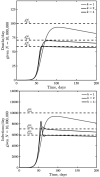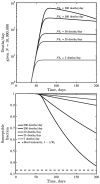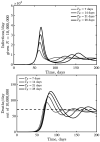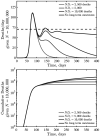This is a preprint.
Awareness-driven Behavior Changes Can Shift the Shape of Epidemics Away from Peaks and Towards Plateaus, Shoulders, and Oscillations
- PMID: 32511479
- PMCID: PMC7273247
- DOI: 10.1101/2020.05.03.20089524
Awareness-driven Behavior Changes Can Shift the Shape of Epidemics Away from Peaks and Towards Plateaus, Shoulders, and Oscillations
Update in
-
Awareness-driven behavior changes can shift the shape of epidemics away from peaks and toward plateaus, shoulders, and oscillations.Proc Natl Acad Sci U S A. 2020 Dec 22;117(51):32764-32771. doi: 10.1073/pnas.2009911117. Epub 2020 Dec 1. Proc Natl Acad Sci U S A. 2020. PMID: 33262277 Free PMC article.
Abstract
The COVID-19 pandemic has caused more than 1,000,000 reported deaths globally, of which more than 200,000 have been reported in the United States as of October 1, 2020. Public health interventions have had significant impacts in reducing transmission and in averting even more deaths. Nonetheless, in many jurisdictions the decline of cases and fatalities after apparent epidemic peaks has not been rapid. Instead, the asymmetric decline in cases appears, in most cases, to be consistent with plateau-or shoulder-like phenomena - a qualitative observation reinforced by a symmetry analysis of US state-level fatality data. Here we explore a model of fatality-driven awareness in which individual protective measures increase with death rates. In this model, fast increases to the peak are often followed by plateaus, shoulders, and lag-driven oscillations. The asymmetric shape of model-predicted incidence and fatality curves are consistent with observations from many jurisdictions. Yet, in contrast to model predictions, we find that population-level mobility metrics usually increased from low early-outbreak levels before peak levels of fatalities. We show that incorporating fatigue and long-term behavior change can reconcile the apparent premature relaxation of mobility reductions and help understand when post-peak dynamics are likely to lead to a resurgence of cases.
Figures







References
-
- IHME COVID-19 health services utilization forecasting team, Murray CJ (2020) Forecasting COVID-19 impact on hospital bed-days, ICU-days, ventilator-days and deaths by US state in the next 4 months. medRxiv https://www.medrxiv.org/content/10.1101/2020.03.27.20043752v1. - DOI
-
- Bregman DJ, Langmuir AD (1990) Farr’s law applied to AIDS projections. JAMA 263:1522–1525. - PubMed
-
- Ferguson NM, et al. (2020) Impact of non-pharmaceutical interventions (NPIs) to reduce COVID19 mortality and healthcare demand. https://www.imperial.ac.uk/mrc-global-infectious-disease-analysis/covid-.... - PMC - PubMed
Publication types
Grants and funding
LinkOut - more resources
Full Text Sources
